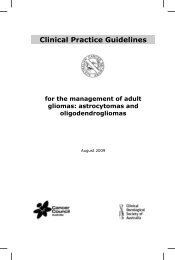Clinical Practice Guidelines for the management of locally advanced ...
Clinical Practice Guidelines for the management of locally advanced ...
Clinical Practice Guidelines for the management of locally advanced ...
You also want an ePaper? Increase the reach of your titles
YUMPU automatically turns print PDFs into web optimized ePapers that Google loves.
Side effects (toxicity)<br />
As <strong>the</strong>se radioisotopes are taken up by bone, <strong>the</strong>y have <strong>the</strong> potential to suppress <strong>the</strong> bone marrow and<br />
result in low red and white blood cell and platelet counts which can <strong>the</strong>n lead to dependence on blood<br />
transfusions, increased risk <strong>of</strong> infections and easy bruising. Patients who have low blood counts at <strong>the</strong><br />
outset would generally be regarded as being unsuitable and ineligible <strong>for</strong> this treatment.<br />
All <strong>the</strong> strontium 89 and samarium 153 trials reported toxicity outcomes.<br />
Thrombocytopenia and/or leucopenia were observed to some extent in all studies. strontium 89 tends<br />
to show a similar or worse effect on thrombocytopenia and leucopenia than hemibody and local<br />
irradiation 48, 49 , more effect than ‘best supportive care’ 46, 47 , and statistically significantly more effect<br />
when added to localised radiation. 52-54 There is no good evidence that strontium 89 causes significant<br />
adverse effects o<strong>the</strong>r than haematological. All <strong>the</strong> samarium trials demonstrate a reduction in platelets<br />
and white cell count with samarium 153. In one trial this effect is statistically significant <strong>for</strong> white<br />
blood cell toxicity. 56 However, <strong>the</strong> development <strong>of</strong> grade III or IV neutropaenia is uncommon<br />
(



